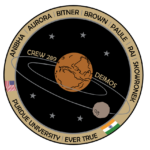Mars Desert Research Station
Mission Plan
Crew 289 – Deimos
Dec 25th, 2023 – Jan 6th, 2023
Crew Members:
Commander: Adriana Brown
Executive Officer and Crew Journalist: Sara Paule
Crew Geologist: Eshaana Aurora
Crew Engineer: Nathan Bitner
Health and Safety Officer and Crew Astronomer: Gabriel Skowronek
Green Hab Officer and Crew Biologist: Riya Raj
Crew Scientist: Aditya Arjun Anibha

Mission Plan:
The twin “Phobos” (288) and “Deimos” (289) missions are the sixth and seventh all-Purdue crew at MDRS. The enthusiasm and interest raised by the previous experiences of Purdue students and alumni at the station, the numerous high-quality research projects carried on at MDRS, as well as Purdue’s honored tradition in the field of space exploration, allowed us the amazing opportunity to complete two back-to-back rotations. Crew 289’s projects span engineering, astronomy, geology, biology, and human factors fields.
The main objectives of the Deimos analog Martian mission are:
Performing research in the fields of geology, engineering, human factors, astronomy, on Mars.
Experimenting with personnel at Purdue, providing a simulated mission control center to coordinate and support research and operations (including delay in communication, to simulate Earth-Mars distance).
Continuing the fruitful collaboration of Purdue crews with the MDRS program.
Following the mission, supporting MDRS with useful results for future crews.
Crew Projects:
Title: Remote Station Monitoring
Author: Nathan Bitner
Objectives: Demonstrate usefulness of supplying on-site crew and mission control with real time habitat data
Description: This project entails the creation of 10 separate sensor modules. Five of these measure air quality data from the various simulation buildings, and 5 measure the status of the various doors and airlocks on the station. Each of these modules send both manual and automatic updates to an Adafruit monitoring dashboard.
Rationale: In real Mars missions essential life support and other systems would be monitored closely by both crew and mission control. This project allows for the creation of a remote monitoring system that more closely resembles that setup.
EVAs: None
Title: Recording Dust Levels in the HAB
Author(s): Gabriel Skowronek
Objectives: Qualitatively determine the dust levels before and after cleaning procedures
Description: Areas and surfaces in both the upper and lower decks of the HAB will be swabbed using cotton swabs. Then using a handheld magnifier, a qualitative description of the observed dust will be made, which will include details like relative amounts and the type of contaminants (i.e. fibers, dirt/particulates). This will be done at least once a day throughout different locations to see if the amounts of dust vary throughout the crew rotation and where buildup occurs the most. Furthermore, swabbing will be done before and after cleaning procedures to see the effectiveness of cleaning methods.
Rationale: Mars’ surface poses serious risk to human health due to the Martian dust, made up of extremely fine particles. Minimizing the presence of dust in living quarters is a necessary step to reduce dependence on Earth’s supplies and medical interventions, especially given the potential infrequency of resupply missions and limited availability of supplies. This project prioritizes safeguarding the fundamental and most fragile aspect of Mars missions: the health and wellbeing of astronauts.
EVAs: None
Title: Astronomy on Mars
Author(s): Gabriel Skowronek
Objectives: Determine the period of variation for SW Tauri, a Cepheid variable. Furthermore, it will be helpful to make impressive pictures of the Crab and Orion nebulae.
Description: Using the RCOS-16 telescope to conduct photometry, intensity measurements will be made over a two-week period to construct a light-curve of SW Tauri. To conduct astrophotography, the MDRS-WF will be used to capture the Crab and Orion nebulae. To process the images, Astro ImageJ and Adobe Photoshop will be used.
Rationale: Making astronomical measurements of Cepheid variables, such as SW Tauri, prove useful to the field of cosmology due their usefulness in determining cosmological distances. Furthermore, the astrophotography will be used in outreach to show what is capable of being done at MDRS and to inspire others to pursue astronomy at MDRS and in general.
EVAs: None
Title: Comparison of Self-selection Traits versus Skill Utilization by Mars Colonists
Author(s): Sara Paule
Objectives: Examine the skills (e.g., flexibility, leadership, communication, problem-solving, domestic skills, etc.) most commonly used by “colonists” in their day-to-day activities at the Mars Desert Research Station (MDRS) versus their ratings of importance pre- and post-mission.
Description: This study will cross-compare daily usage of skills to those common in crew member volunteers and, post-mission will ask crew members to then rate the importance of skill necessity for success as a “colonist.” Pre-mission surveys have already been completed by the crew. During mission, at the end of each day, crew members will complete a brief 10-minute paper survey on which skills they utilized in their day-to-day activities at the Mars Desert Research Station (MDRS). As time allows, paper survey results will be manually transferred to electronic coding; however, this step can readily be completed post-mission.
Rationale: Space exploration and colonization missions will require their crews to possess a variety of skills to optimize the chances for success. Organizations selecting individuals for such missions look for certain traits within individuals and attempt to diverse across the crew; yet, there are no published rubrics for selection criteria.
Title: Establishing Best Practices in Mission Reporting from Prior Crew Reports
Author(s): Sara Paule
Objective 1: Establish the average word length of the various report styles.
Objective 2: Examine whether crew members are most often referenced by surname/family name, given name, or both.
Objective 3: Determine common subject matters within reports, such as references to meals, sleep, showering, etc.
Description: Examine past MDRS reports on the following priority order:
Journalist Report (daily)
Sol Summary (daily)
Research Report (two-times per mission)
Mission Plan (one-time per mission)
Mission Summary (one-time per mission)
EVA Report (after any EVA)
Usage of a flexible coding technique will allow for addition of new content categories as analysis proceeds for Objective 3. All data will be entered into a spreadsheet to track basic statistics such as counts and averages.
Rationale: Regular reporting between crews and Mission Support is a requirement of the Mars Desert Research Station (MDRS) program and will be essential between Mars colonists and Mission Support on Earth. The MDRS Handbook outlines the schedule for reporting requirements and provides access to templates with some guidance on how to optimally report.
Title: Martian analog paleotemperature reconstruction
Author(s): Adriana Brown
Objectives: Sample a measured section of sediments up the side of Hab Ridge and identify the percent of carbonate present, collect Pycnodonte fossils from the Tununk shale near Hab Ridge and Sea of Shells for carbonate clumped isotope analysis, identify bentonite presence and frequency within the Tununk Shale, and catalog and prepare samples for drilling.
Description: This project will collect sediment samples from the Tununk Shale to study the coastline of the Cretaceous Western Interior Seaway. Sediments will be collected from a measured section up the face of Hab Ridge. Bivalve fossils will be collected from Hab Ridge and Sea of Shells. The samples collected will provide information about the temperature of the seaway during the time the oysters lived using carbonate clumped isotopes, where the carbonate is sourced from bivalves and foraminifera. At MDRS, the sediment samples will be tested for weight percent carbonate and bivalve fossils cleaned, labeled, and catalogued. At University of Michigan, the geochemistry will be completed post-mission.
Rationale: With the onset of cutting-edge geochemistry, the temperature and dynamics of ancient water systems can be determined better than ever before. Performing analysis on carbonates will be essential to understanding climate history on Mars due to their power to record seawater temperature and isotopic composition – abiotic factors that determine essential biological controls, such as oxygenation and environmental habitability. These results will be integrated into my wider research project which aims to reconstruct latitudinal temperature gradients of the Western Interior Seaway – an important control on climate sensitivity.
EVAs: 3-4 medium – long duration EVAs
Title: Mars Exploration by Origami Robot and Drone Scouting or Transportation
Author(s): Aditya Arjun Anibha
Objectives: Apply the concept of transformable origami robots that can exhibit multiple types of locomotion and test their ability to supplement exploration. Investigate feasibility of transporting robot using drone and scouting locations of interest prior to exploration.
Description: Investigating transforming origami robotics with multiple modes of locomotion by testing and demonstrating their effectiveness for extraterrestrial exploration over conventional wheeled rovers. The robot will also be tested for its efficiency, robustness and endurance in this environment. Tests will be conducted in Chandor Chasma as it has diverse terrain types. The robot will be attached to a Skydio drone and transported to and across Candor Chasma. Alternatively, the drone will be used to impart a vertical force upon to counteract Earth gravity to simulate locomotion conditions similar to those on Mars. The drone has security systems to avoid obstacles and contact with astronauts. A lightweight carrying harness will be tied to the drone to create a safe range to the payload to avoid interfering with the sensors. The drone will also be used to conduct scouting for exploration locations of interest for the robot prior to its excursion.
Rationale: Due to the lack of infrastructure on Mars, unique and adaptable methods of locomotion and robots will likely be needed for initial exploration beyond wheeled rovers. Drones would be useful for supplementing exploration with scouting and transportation.
EVAs: 2-3
Title: Miniaturized Martian Agrivoltaics
Author(s): Eshaana Aurora
Objectives: To comprehensively test the impact of solar and artificial irradiation on crop yields within an enclosed, module-like environment. To understand the feasibility of a miniaturized agrivoltaic farm within the MDRS Greenhab.
Description: The project at hand seeks to create a mini agrivoltaic farm within the Martian Desert Research Station’s (MDRS) Greenhab. This study aims to delve into the realm of agrivoltaics, applying its principles to extraterrestrial greenhouse modules. By studying the impact of solar and artificial irradiation on crop yield within the constraints of a mini agrivoltaic farm in the Martian Desert Research Station’s Greenhab, the project aims to provide insights into optimizing land use efficiency on Mars. The mission plan involves meticulous experiments, data analysis, and the formulation of recommendations to advance sustainable agriculture for future Martian colonies while addressing the challenges posed by potential dust storms.
Rationale: As the world grapples with the ever-increasing relevance of solar energy, a constant dilemma has arisen between allocating land for agriculture and dedicating it to solar energy production. Agrivoltaics, a promising solution, represents a system that seamlessly integrates agricultural practices with solar energy production, thus mitigating the competition between our energy and food requirements. As humanity sets its sights on colonizing Mars, the efficient utilization of land resources becomes a paramount concern.
EVAs: 0
Title: LiDAR Scanning of Terrain
Author(s): Riya Raj
Objectives: Will use phone apps to provide accessible scans of the terrain.
Description: Conducting LiDAR scans of the terrain and plants for structural analysis and plant growth structures
Rationale: Provides civil application for future life support systems and planning for efficient living.
Title: Radiation on Kale:
Author: Riya Raj
Description: Working on sustainable methods of growing veggies using simulations in hydroponics to provide fresh nutrients for the body.
Rationale: Keeping our bodies healthy with essential minerals can help with blood pressure levels, red blood cell production, and digestive health!
Title: Indoor Air Quality
Author: Riya Raj
Objectives: Use sensors to monitor air quality
Description: I will be setting up sensor monitors within the stations to track the levels of CO2, PM 2.5, TVOC, and Ozone to ensure proper ventilation for the crews.
Rationale: Monitoring both indoor/outdoor air quality and ventilation levels is important for human health and performance in any setting. For example, high levels of CO2 can cause nausea and fatigue while high levels of PM 2.5 can cause lung diseases and infections.










You must be logged in to post a comment.